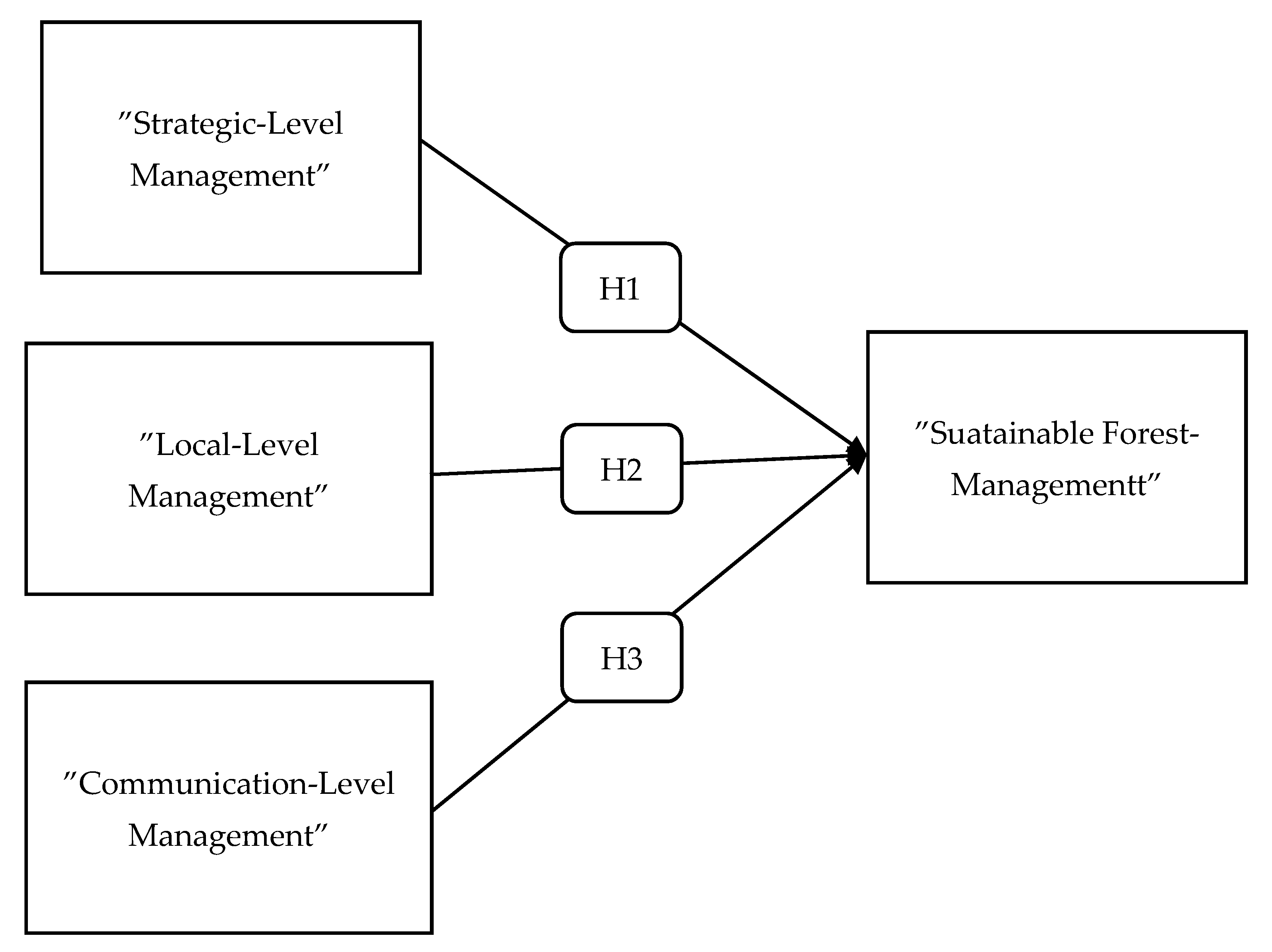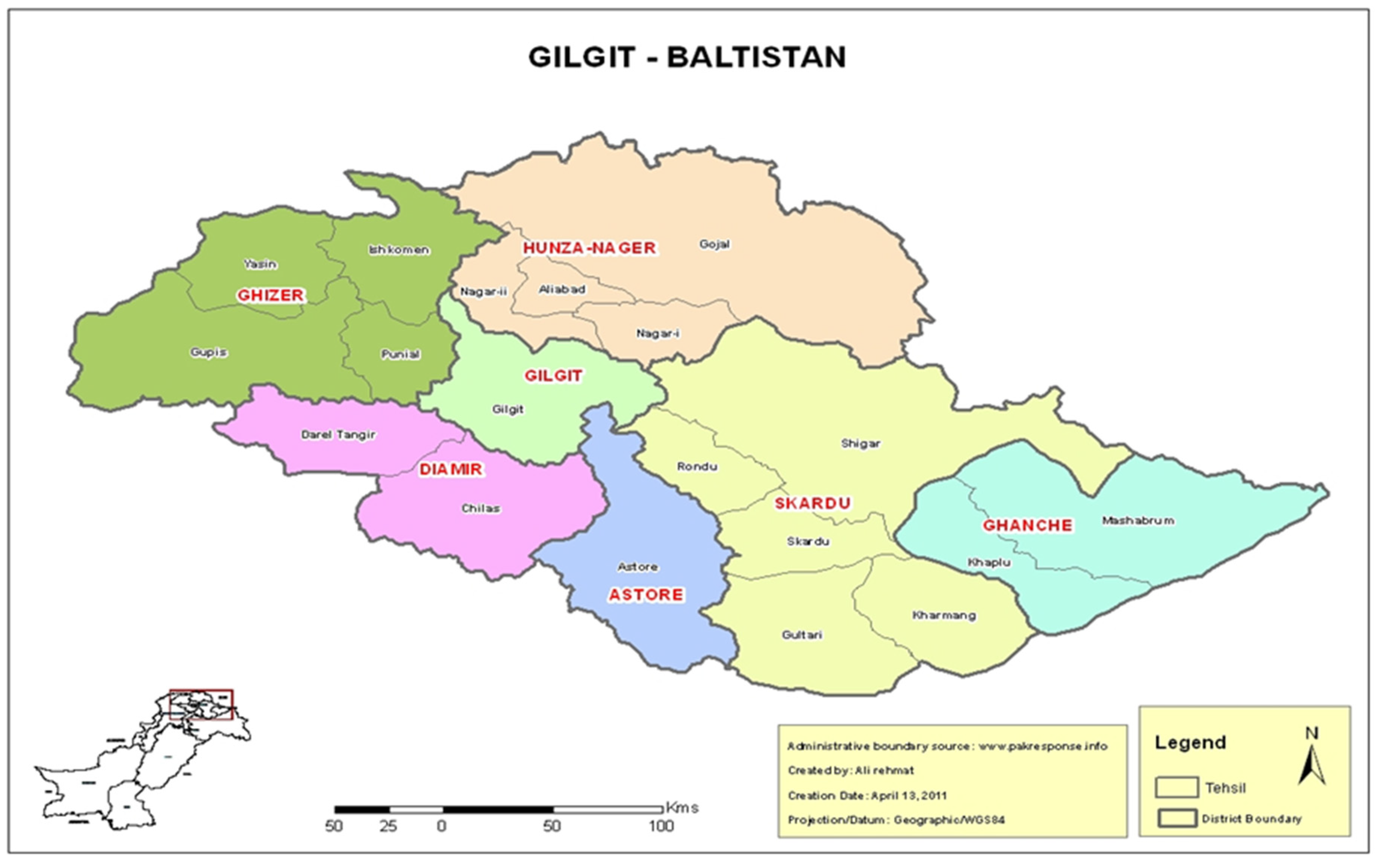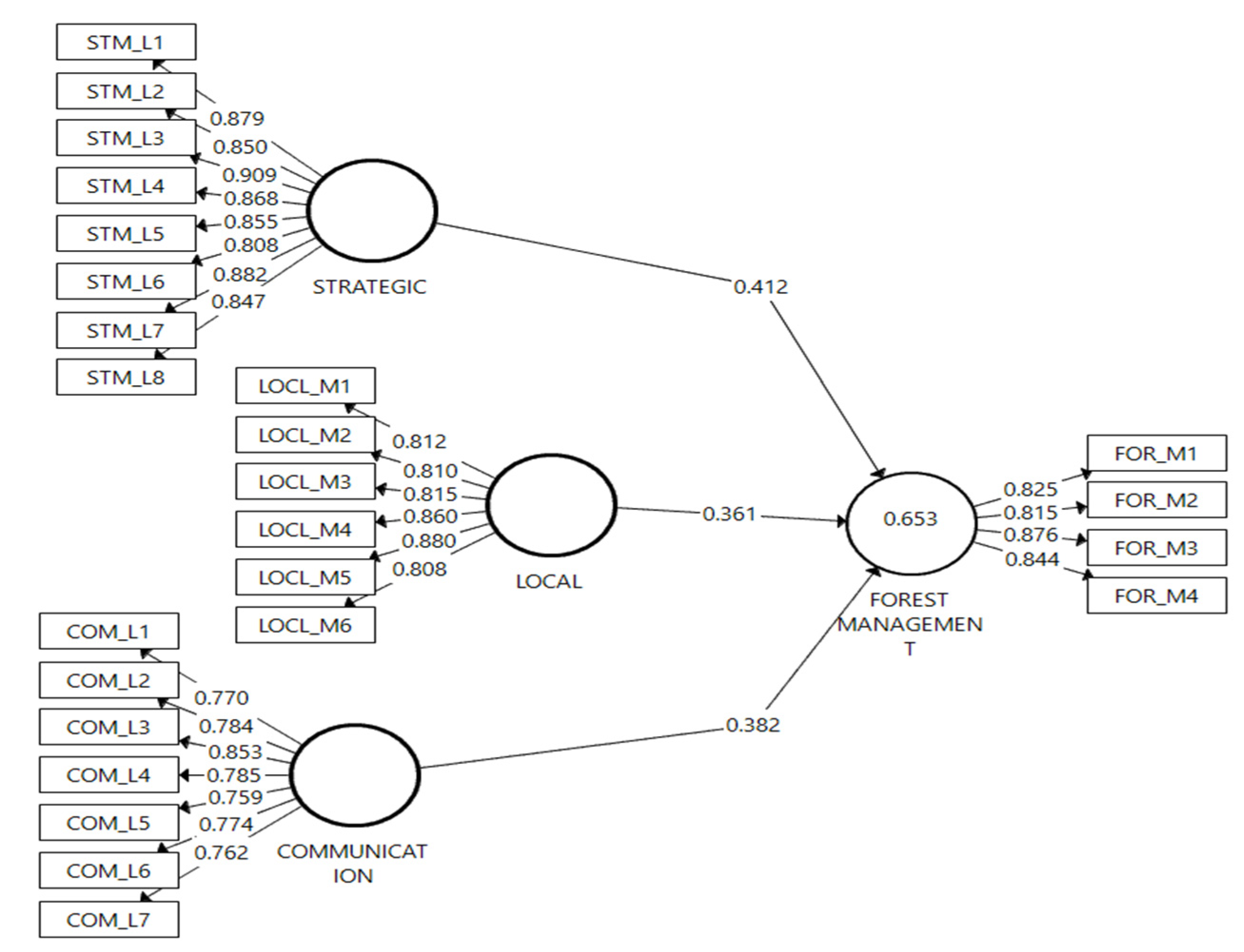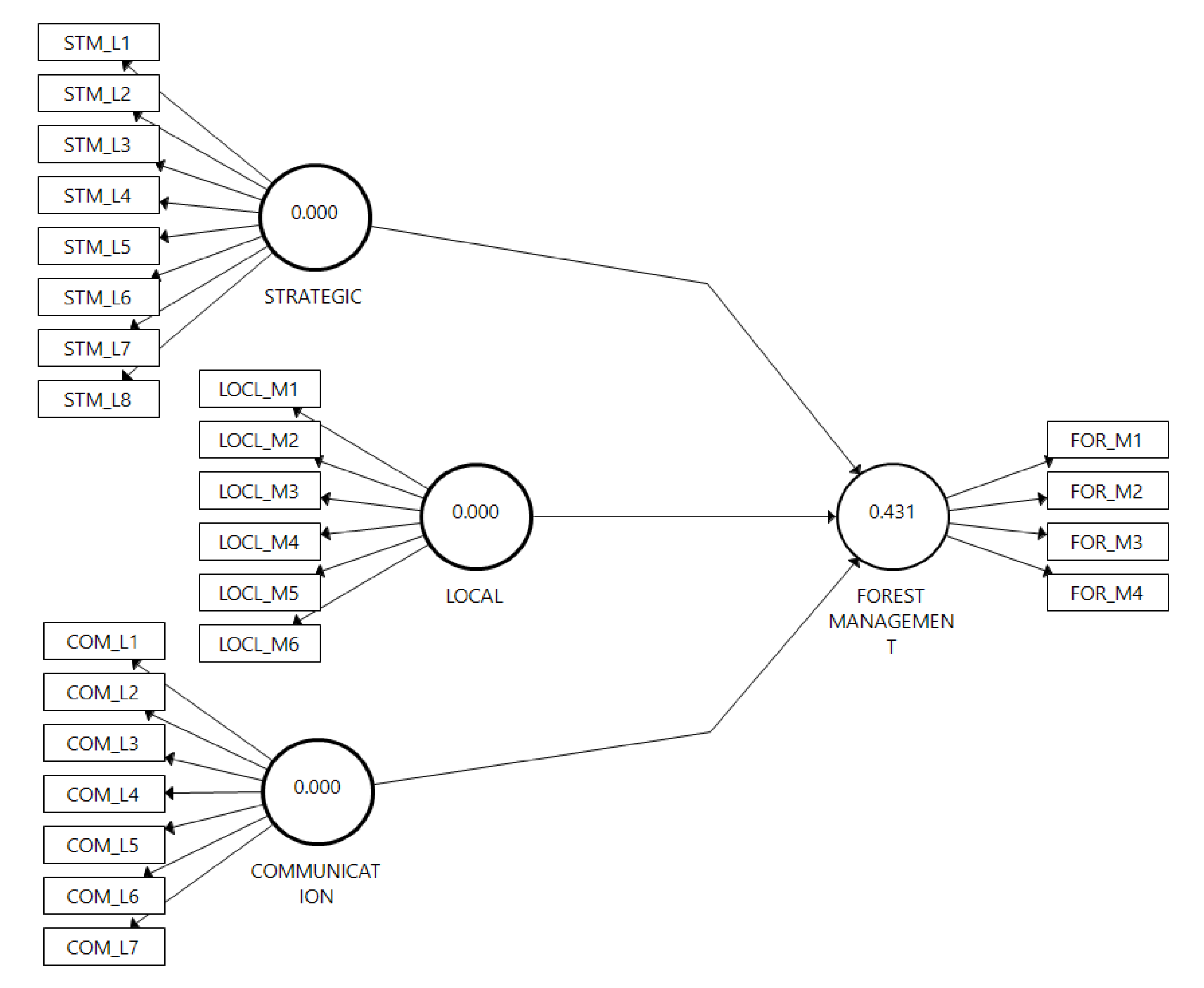Forest Resource Management: An Empirical Study in Northern Pakistan
Abstract
:1. Introduction
2. Literature Review
2.1. Public Sharing in Sustainable Forest Management
2.2. Government Sharing in Sustainable Forest Management
2.3. Sustainable Forest Management
“The stewardship and use of forests and forest lands in a way, and at a rate, that maintains their biodiversity, productivity, regeneration capacity, vitality and their potential to fulfill, now and in the future, relevant ecological, economic and social functions, at local, national, and global levels, and that does not cause damage to other ecosystems.”
2.4. Current Forest-Management Situation in Gilgit–Baltistan, Pakistan
3. The Hypothesis of the Study
4. Materials and Methods
4.1. Preliminary List of Factors
4.2. Pilot Study and Questionnaire Design
4.3. Respondents’ Demographics
4.4. Sampling and Data Collection
5. Results
5.1. Evaluation of Outer Measurement Model
5.2. Evaluation of the Inner Structural Model
5.2.1. Value of R2
5.2.2. Assessment of Path Coefficients (β) and T-Statistics
5.2.3. Measuring the Effect Size (ƒ2)
5.2.4. Predictive Relevance of the Model (Q2)
5.2.5. Goodness-of-Fit Index
5.2.6. The Standardized Root Mean Square Residual (SRMR)
5.3. Correlation Coefficient of Latent Variables
6. Discussion and Recommendations
7. Conclusions
Author Contributions
Funding
Institutional Review Board Statement
Informed Consent Statement
Data Availability Statement
Conflicts of Interest
Appendix A
| Items | Mean | Standard Deviation | Excess Kurtosis | Skewness |
| COM_L1 | 3.369 | 0.977 | −0.717 | 0.043 |
| COM_L2 | 3.376 | 0.986 | −0.604 | −0.072 |
| COM_L3 | 3.196 | 0.950 | −0.376 | −0.043 |
| COM_L4 | 3.525 | 1.001 | −0.166 | −0.377 |
| COM_L5 | 3.663 | 0.988 | −0.345 | −0.410 |
| COM_L6 | 3.467 | 0.989 | −0.564 | −0.237 |
| COM_L7 | 3.647 | 0.995 | −0.998 | −0.207 |
| LOCL_M1 | 3.651 | 0.978 | −0.479 | −0.290 |
| LOCL_M2 | 3.275 | 1.011 | −0.501 | −0.160 |
| LOCL_M3 | 3.043 | 0.979 | −0.278 | −0.188 |
| LOCL_M4 | 3.110 | 0.972 | −0.574 | 0.010 |
| LOCL_M5 | 3.153 | 0.964 | −0.519 | −0.073 |
| LOCL_M6 | 2.776 | 1.026 | −0.434 | 0.065 |
| STM_L1 | 3.761 | 1.007 | −0.471 | −0.457 |
| STM_L2 | 3.682 | 0.919 | −0.614 | −0.243 |
| STM_L3 | 3.800 | 0.988 | −0.340 | −0.498 |
| STM_L4 | 3.235 | 1.017 | −0.375 | −0.171 |
| STM_L5 | 3.784 | 0.972 | −0.448 | −0.431 |
| STM_L6 | 3.525 | 1.001 | −0.365 | −0.306 |
| STM_L7 | 2.722 | 0.965 | −0.464 | 0.108 |
| STM_L8 | 2.733 | 0.962 | −0.469 | 0.104 |
| FOR_M1 | 3.600 | 0.981 | −0.530 | −0.232 |
| FOR_M2 | 2.902 | 1.003 | −0.322 | −0.013 |
| FOR_M3 | 3.804 | 0.946 | −0.129 | −0.493 |
| FOR_M4 | 3.592 | 0.997 | −0.722 | −0.185 |
References
- Berg, S.; Lindholm, E.-L. Energy use and environmental impacts of forest operations in Sweden. J. Clean. Prod. 2005, 13, 33–42. [Google Scholar] [CrossRef]
- Buchy, M.; Hoverman, S. Understanding public participation in forest planning: A review. For. Policy Econ. 2000, 1, 15–25. [Google Scholar] [CrossRef]
- Shackleton, S.; Campbell, B.; Wollenberg, E.; Edmunds, D. Devolution and community-based natural resource management: Creating space for local people to participate and benefit. Nat. Resour. Perspect. 2002, 76, 1–6. [Google Scholar]
- Shrivastava, P. The role of corporations in achieving ecological sustainability. Acad. Manag. Rev. 1995, 20, 936–960. [Google Scholar] [CrossRef]
- Leach, M.; Mearns, R.; Scoones, I. Environmental entitlements: Dynamics and institutions in community-based natural resource management. World Dev. 1999, 27, 225–247. [Google Scholar] [CrossRef] [Green Version]
- Tanz, J.S.; Howard, A.F. Meaningful public participation in the planning and management of publicly owned forests. For. Chron. 1991, 67, 125–130. [Google Scholar] [CrossRef] [Green Version]
- Pearce, D.; Barbier, E.; Markandya, A. Sustainable Development: Economics and Environment in the Third World; Routledge: London, UK, 2013. [Google Scholar]
- Rametsteiner, E.; Simula, M. Forest certification—An instrument to promote sustainable forest management? J. Environ. Manag. 2003, 67, 87–98. [Google Scholar] [CrossRef]
- Manojlović, S.; Antić, M.; Šantić, D.; Sibinović, M.; Carević, I.; Srejić, T. Anthropogenic Impact on Erosion Intensity: Case Study of Rural Areas of Pirot and Dimitrovgrad Municipalities, Serbia. Sustainability 2018, 10, 826. [Google Scholar] [CrossRef] [Green Version]
- Lee, C.-H.; Wang, C.-H. Estimating Residents’ Preferences of the Land Use Program Surrounding Forest Park, Taiwan. Sustainability 2017, 9, 598. [Google Scholar] [CrossRef] [Green Version]
- Demirović, D.; Radovanović, M.; Petrović, M.D.; Cimbaljević, M.; Vuksanović, N.; Vuković, D.B. Environmental and Community Stability of a Mountain Destination: An Analysis of Residents’ Perception. Sustainability 2018, 10, 70. [Google Scholar] [CrossRef] [Green Version]
- Davis, L.S.; Johnson, K.N. Forest Management; McGraw-Hill Book Company: New York, NY, USA, 1987. [Google Scholar]
- Johnson, D.W.; Curtis, P.S. Effects of forest management on soil C and N storage: Meta analysis. For. Ecol. Manag. 2001, 140, 227–238. [Google Scholar] [CrossRef]
- Pritchett, W.L. Properties and management of forest soils. Soil Sci. 1980, 129, 389. [Google Scholar] [CrossRef]
- Burton, P.J.; Messier, C.; Smith, D.W.; Adamowicz, W.L. Towards Sustainable Management of the Boreal Forest; NRC Research Press: Ottawa, ON, Canada, 2003. [Google Scholar]
- Royyani, M.F.; Keim, A.P.; Hasanah, I.F.; Sujarwo, W. Forests and the Malays: Historical Perspective on the Forest Management in Sumatera (Indonesia). J. Trop. Ethnobiol. 2021, 4, 66–77. [Google Scholar] [CrossRef]
- Sheppard, S.R.; Meitner, M. Using multi-criteria analysis and visualisation for sustainable forest management planning with stakeholder groups. For. Ecol. Manag. 2005, 207, 171–187. [Google Scholar] [CrossRef]
- Jandl, R.; Lindner, M.; Vesterdal, L.; Bauwens, B.; Baritz, R.; Hagedorn, F.; Johnson, D.W.; Minkkinen, K.; Byrne, K.A. How strongly can forest management influence soil carbon sequestration? Geoderma 2007, 137, 253–268. [Google Scholar] [CrossRef]
- Siitonen, J. Forest management, coarse woody debris and saproxylic organisms: Fennoscandian boreal forests as an example. Ecol. Bull. 2001, 49, 11–41. [Google Scholar]
- Veríssimo, A.; Barreto, P.; Mattos, M.; Tarifa, R.; Uhl, C. Logging impacts and prospects for sustainable forest management in an old Amazonian frontier: The case of Paragominas. For. Ecol. Manag. 1992, 55, 169–199. [Google Scholar] [CrossRef]
- Lindenmayer, D.B.; Kooyman, R.M.; Taylor, C.; Ward, M.; Watson, J.E.M. Recent Australian wildfires made worse by logging and associated forest management. Nat. Ecol. Evol. 2020, 4, 898–900. [Google Scholar] [CrossRef] [PubMed]
- Von Gadow, K.; Pukkala, T.; Tomé, M. Sustainable Forest Management; Springer: Berlin/Heidelberg, Germany, 2012; Volume 1. [Google Scholar]
- Kangas, J. An approach to public participation in strategic forest management planning. For. Ecol. Manag. 1994, 70, 75–88. [Google Scholar] [CrossRef]
- Beckley, T.M.; Parkins, J.R.; Sheppard, S. Public Participation in Sustainable Forest Management: A Reference Guide; Sustainable Forest Management Network: Edmonton, AB, Canada, 2006. [Google Scholar]
- Shindler, B.; Steel, B.; List, P. Public judgments of adaptive management: A response from forest communities. J. For. 1996, 94, 4–12. [Google Scholar]
- Wells, W.D.; Tigert, D.J.; Activities, I. Opinions. J. Advert. Res. 1971, 11, 27–35. [Google Scholar]
- Shindler, B.; Cramer, L.A. Shifting public values for forest management: Making sense of wicked problems. West. J. Appl. For. 1999, 14, 28–34. [Google Scholar] [CrossRef] [Green Version]
- Murray Li, T. Practices of assemblage and community forest management. Econ. Soc. 2007, 36, 263–293. [Google Scholar] [CrossRef]
- Nygren, A. Community-based forest management within the context of institutional decentralization in Honduras. World Dev. 2005, 33, 639–655. [Google Scholar] [CrossRef]
- Mohammed, A.J.; Inoue, M.; Shivakoti, G. Moving forward in collaborative forest management: Role of external actors for sustainable Forest socio-ecological systems. For. Policy Econ. 2017, 74, 13–19. [Google Scholar] [CrossRef]
- Pagdee, A.; Kim, Y.-S.; Daugherty, P.J. What makes community forest management successful: A meta-study from community forests throughout the world. Soc. Nat. Resour. 2006, 19, 33–52. [Google Scholar] [CrossRef]
- Klooster, D.; Masera, O. Community forest management in Mexico: Carbon mitigation and biodiversity conservation through rural development. Glob. Environ. Chang. 2000, 10, 259–272. [Google Scholar] [CrossRef]
- Kumar, S. Does “participation” in common pool resource management help the poor? A social cost–benefit analysis of joint forest management in Jharkhand, India. World Dev. 2002, 30, 763–782. [Google Scholar] [CrossRef]
- Grieg-Gran, M.; Porras, I.; Wunder, S. How can market mechanisms for forest environmental services help the poor? Preliminary lessons from Latin America. World Dev. 2005, 33, 1511–1527. [Google Scholar] [CrossRef]
- Lewis, J.L.; Sheppard, S.R. Culture and communication: Can landscape visualization improve forest management consultation with indigenous communities? Landsc. Urban Plan. 2006, 77, 291–313. [Google Scholar] [CrossRef]
- Kates, R.W.; Parris, T.M.; Leiserowitz, A. What is Sustainable Development? Goals, Indicators, Values, and Practice. Environ. Sci. Policy 2018, 47, 8–21. [Google Scholar]
- Whitmore, T.; Laurance, W.F.; Bierregaard, R. Tropical Forest Remnants: Ecology, Management, and Conservation of Fragmented Communities; University of Chicago Press: Chicago, IL, USA, 1997. [Google Scholar]
- Paluš, H.; Parobek, J.; Šulek, R.; Lichý, J.; Šálka, J. Understanding Sustainable Forest Management Certification in Slovakia: Forest Owners’ Perception of Expectations, Benefits and Problems. Sustainability 2018, 10, 2470. [Google Scholar] [CrossRef] [Green Version]
- Wolfslehner, B.; Vacik, H. Evaluating sustainable forest management strategies with the analytic network process in a pressure-state-response framework. J. Environ. Manag. 2008, 88, 1–10. [Google Scholar] [CrossRef]
- Wu, D.D.; Olson, D.L.; Birge, J.R. Risk management in cleaner production. J. Clean. Prod. 2013, 53, 1–6. [Google Scholar] [CrossRef]
- Rawat, Y.S.; Tekleyohannes, A.T. Sustainable forest management and forest products industry development in Ethiopia. Int. For. Rev. 2021, 23, 197–218. [Google Scholar]
- Spector, B.I.; Sjöstedt, G.; Zartman, I.W. Negotiating International Regimes: Lessons Learned from the United Nations Conference on Environment and Development (UNCED); Graham & Trotman/Martinus Nijhoff: London, UK, 1994. [Google Scholar]
- Johansson, T.B.; Reddy, A.K.; Kelly, H.; Williams, R.H.; Burnham, L. Renewable Energy: Sources for Fuels and Electricity; Island Press: Washington, DC, USA, 1993. [Google Scholar]
- Sombroek, W.; Sims, D. Planning for Sustainable Use of Land Resources: Towards a New Approach. Background Paper to FAO’s Task Managership for Chapter 10 of Agenda 21 of the United Nations Conference on Environment and Development (UNCED); FAO: Rome, Italy, 1995. [Google Scholar]
- Stupak, I.; Asikainen, A.; Jonsell, M.; Karltun, E.; Lunnan, A.; Mizaraitė, D.; Pasanen, K.; Pärn, H.; Raulund-Rasmussen, K.; Röser, D. Sustainable utilisation of forest biomass for energy—Possibilities and problems: Policy, legislation, certification, and recommendations and guidelines in the Nordic, Baltic, and other European countries. Biomass Bioenergy 2007, 31, 666–684. [Google Scholar] [CrossRef]
- Myers, N. The world’s forests: Problems and potentials. Environ. Conserv. 1996, 23, 156–168. [Google Scholar] [CrossRef]
- Akbar, M.; Khan, H.; Hussain, A.; Hyder, S.; Begum, F.; Khan, M.; Ali, S.; Hussian, S.A.; Khan, G.; Abbas, Q. Present status and future trend of chilghoza forest in Goharabad, District Diamer, Gilgit-Baltistan, Pakistan. J. Biodivers. Environ. Sci. 2014, 5, 253–261. [Google Scholar]
- Rizwan, K. Deforestation in Gilgit-Baltistan; a Green Annihilation or Astorm in a Teacup? 2014. Available online: https://pamirtimes.net/2014/11/07/deforestation-in-gilgit-baltistan-a-green-annihilation-or-astorm-in-a-teacup/ (accessed on 14 June 2021).
- Meijaard, E.; Santika, T.; Wilson, K.A.; Budiharta, S.; Kusworo, A.; Law, E.A.; Struebig, M.J. Toward improved impact evaluation of community forest management in Indonesia. Conserv. Sci. Pract. 2021, 3, e189. [Google Scholar] [CrossRef]
- Zain, O.F. A Socio-Political Study of Gilgit Baltistan Province. Pak. J. Soc. Sci. (PJSS) 2010, 30, 181–190. Available online: https://citeseerx.ist.psu.edu/viewdoc/download?doi=10.1.1.717.1246&rep=rep1&type=pdf (accessed on 18 March 2021).
- Rigdon, E.E.; Sarstedt, M.; Ringle, C.M. On comparing results from CB-SEM and PLS-SEM: Five perspectives and five recommendations. Mark. ZFP J. Res. Manag. 2017, 39, 4–16. [Google Scholar] [CrossRef]
- Bamgbade, J.A.; Kamaruddeen, A.M.; Nawi, M.N.M.; Yusoff, R.Z.; Bin, R.A. Does government support matter? Influence of organizational culture on sustainable construction among Malaysian contractors. Int. J. Constr. Manag. 2018, 18, 93–107. [Google Scholar] [CrossRef]
- Lin, C.-L.; Jeng, C.-H. Exploring Interface Problems in Taiwan’s Construction Projects Using Structural Equation Modeling. Sustainability 2017, 9, 822. [Google Scholar] [CrossRef] [Green Version]
- Gefen, D.; Straub, D.; Boudreau, M.-C. Structural equation modeling and regression: Guidelines for research practice. Commun. Assoc. Inf. Syst. 2000, 4, 7. [Google Scholar] [CrossRef] [Green Version]
- Hair, J.F.; Ringle, C.M.; Sarstedt, M. Partial least squares structural equation modeling: Rigorous applications, better results and higher acceptance. Long Range Plan. 2013, 46, 1–12. [Google Scholar] [CrossRef]
- Peng, D.X.; Lai, F. Using partial least squares in operations management research: A practical guideline and summary of past research. J. Oper. Manag. 2012, 30, 467–480. [Google Scholar] [CrossRef]
- Ho, R. Handbook of Univariate and Multivariate Data Analysis with IBM SPSS; Chapman and Hall/CRC: Boca Rotan, FL, USA, 2013. [Google Scholar]
- Hair, J.F.; Sarstedt, M.; Ringle, C.M.; Mena, J.A. An assessment of the use of partial least squares structural equation modeling in marketing research. J. Acad. Mark. Sci. 2012, 40, 414–433. [Google Scholar] [CrossRef]
- Götz, O.; Liehr-Gobbers, K.; Krafft, M. Evaluation of structural equation models using the partial least squares (PLS) approach. In Handbook of Partial Least Squares; Springer: Berlin/Heidelberg, Germany, 2010; pp. 691–711. [Google Scholar]
- Chin, W.W. The Partial Least Squares Approach to Structural Equation Modeling. In Modern Methods for Business Research; Lawrence Erlbaum Associates Publishers: Mahwah, NJ, USA, 1998; pp. 295–336. [Google Scholar]
- Fornell, C.; Larcker, D.F. Evaluating Structural Equation Models with Unobservable Variables and Measurement Error. J. Mark. Res. 1981, 18, 39–50. [Google Scholar] [CrossRef]
- Hair, J.F., Jr.; Sarstedt, M.; Hopkins, L.; Kuppelwieser, V.G. Partial least squares structural equation modeling (PLS-SEM) An emerging tool in business research. Eur. Bus. Rev. 2014, 26, 106–121. [Google Scholar] [CrossRef]
- Cohen, J. Statistical Power Analysisfor the Beharioarai Sciences; Lawrence Eribaum: Hillsdale, NJ, USA, 1988. [Google Scholar]
- Tenenhaus, M.; Esposito Vinzi, V.; Chatelin, Y.-M.; Lauro, C. PLS Path Modeling. Comput. Stat. Data Anal. 2005, 48, 159–205. [Google Scholar] [CrossRef]
- Henseler, J.; Hubona, G.; Ray, P.A. Using PLS path modeling in new technology research: Updated guidelines. Ind. Manag. Data Syst. 2016, 116, 2–20. [Google Scholar] [CrossRef]
- Eaton-González, R.; Andrade-Sánchez, J.; Montaño-Soto, T.; Andrade-Tafoya, P.; Brito-Jaime, D.; González-Estupiñán, K.; Balderas-López, S. Participatory Mapping as a Didactic and Auxiliary Tool for Learning Community Integration, Technology Transference, and Natural Resource Management. ISPRS Int. J. Geo-Inf. 2021, 10, 206. [Google Scholar] [CrossRef]
- Ojima, D.S.; Conant, R.T.; Parton, W.J.; Lackett, J.M.; Even, T.L. Recent climate changes across the Great Plains and implications for natural resource management practices. Rangel. Ecol. Manag. 2021. [Google Scholar] [CrossRef]





| Code | Factors |
|---|---|
| Strategic-Level-Management Factor (STM_L) | |
| STM_L1 | Central legislation |
| STM_L2 | Check and control |
| STM_L3 | Professional forestry planning |
| STM_L4 | Protected forestry areas |
| STM_L5 | Input opportunities and policy implementation |
| STM_L6 | Protect aesthetic values |
| STM_L7 | Security for forestry companies |
| STM_L8 | Attention on timber resources |
| Local-Level-Management Factor (LOCL_L) | |
| LOCL_L1 | Responsive to public concerns |
| LOCL_L2 | The direct benefit for the local community |
| LOCL_L3 | Instant economic benefit from forest |
| LOCL_L4 | A fair share of locally generated government income |
| LOCL_L5 | Environment-sensitive initiatives for locals |
| LOCL_L6 | Useful infrastructure for local forestry |
| Communication-Level-Management Factor (COM_L) | |
| COM_L1 | Get information about the forest through media |
| COM_L2 | Aware of current situations of the forest through local government bodies |
| COM_L3 | Trusted information among forest managers and local people |
| COM_L4 | Can post any problem with forest situation |
| COM_L5 | A good information way available toward misuse of forest resources |
| COM_L6 | Take necessary actions on the news posted in mass media about any forest management issue |
| COM_L7 | A good communication channel available between central and local government for forest management |
| Sustainable-Forest-Management Factor (FOR_M) | |
| FOR_M1 | A sustainable way of getting information about forest management available |
| FOR_M2 | A strong role of local community participation |
| FOR_M3 | Seen long-term planning for sustainable forest management |
| FOR_M4 | Overall, seen better and sustainable forest-management problem-solving techniques |
| Age | Percentage |
| Less 10 | 0.9 |
| 10–18 | 39.6 |
| 19–30 | 39.6 |
| 31–45 | 14.2 |
| Above 45 | 5.7 |
| Total | 100.0 |
| Education level | |
| Under 10th Grade | 22.6 |
| 10th Grade | 10.4 |
| 12th Grade | 17.9 |
| Bachelor’s | 22.6 |
| Master’s | 25.5 |
| Ph.D. | 0.9 |
| Total | 100.0 |
| Income level | |
| Less than 8000 | 39.6 |
| 8001–15000 | 18.9 |
| 15001–30000 | 12.3 |
| 30001–45000 | 18.9 |
| 45001 and above | 10.4 |
| Total | 100.0 |
| Gender | |
| Male | 46.2 |
| Female | 53.8 |
| Total | 100.0 |
| Material status | |
| Married | 30.2 |
| Unmarried | 68.9 |
| Divorced | 0.9 |
| Total | 100.0 |
| Main Constructs | Items | Loadings | Cronbach’s Alpha | CR | AVE |
|---|---|---|---|---|---|
| Communication-Level Management | COM_L1 | 0.770 | 0.896 | 0.918 | 0.615 |
| COM_L2 | 0.784 | ||||
| COM_L3 | 0.853 | ||||
| COM_L4 | 0.785 | ||||
| COM_L5 | 0.759 | ||||
| COM_L6 | 0.774 | ||||
| COM_L7 | 0.762 | ||||
| Local-Level Management | LOCL_M1 | 0.812 | 0.910 | 0.931 | 0.691 |
| LOCL_M2 | 0.810 | ||||
| LOCL_M3 | 0.815 | ||||
| LOCL_M4 | 0.860 | ||||
| LOCL_M5 | 0.880 | ||||
| LOCL_M6 | 0.808 | ||||
| Strategic-Level Management | STM_L1 | 0.837 | 0.951 | 0.959 | 0.744 |
| STM_L2 | 0.879 | ||||
| STM_L3 | 0.850 | ||||
| STM_L4 | 0.909 | ||||
| STM_L5 | 0.868 | ||||
| STM_L6 | 0.855 | ||||
| STM_L7 | 0.808 | ||||
| STM_L8 | 0.882 | ||||
| Sustainable Forest Management | FOR_M1 | 0.825 | 0.861 | 0.906 | 0.706 |
| FOR_M2 | 0.815 | ||||
| FOR_M3 | 0.876 | ||||
| FOR_M4 | 0.844 |
| COM | FOR | LOCL | STM | |
|---|---|---|---|---|
| Communication-Level Management (COM) | 0.784 | |||
| Sustainable Forest Management (FOR) | 0.554 | 0.840 | ||
| Local-Level Management (LOCL) | 0.243 | 0.559 | 0.832 | |
| Strategic-Level Management (STM) | 0.204 | 0.582 | 0.256 | 0.863 |
| COM | FOR | LOCL | STM | |
|---|---|---|---|---|
| COM_L1 | 0.770 | 0.395 | 0.170 | 0.178 |
| COM_L2 | 0.784 | 0.439 | 0.194 | 0.162 |
| COM_L3 | 0.853 | 0.498 | 0.195 | 0.232 |
| COM_L4 | 0.785 | 0.443 | 0.211 | 0.103 |
| COM_L5 | 0.759 | 0.406 | 0.224 | 0.148 |
| COM_L6 | 0.774 | 0.412 | 0.202 | 0.140 |
| COM_L7 | 0.762 | 0.436 | 0.141 | 0.147 |
| FOR_M1 | 0.472 | 0.825 | 0.459 | 0.457 |
| FOR_M2 | 0.470 | 0.815 | 0.446 | 0.493 |
| FOR_M3 | 0.474 | 0.876 | 0.484 | 0.501 |
| FOR_M4 | 0.445 | 0.844 | 0.489 | 0.503 |
| LOCL_M1 | 0.257 | 0.475 | 0.812 | 0.210 |
| LOCL_M2 | 0.163 | 0.471 | 0.810 | 0.224 |
| LOCL_M3 | 0.229 | 0.478 | 0.815 | 0.193 |
| LOCL_M4 | 0.165 | 0.432 | 0.860 | 0.226 |
| LOCL_M5 | 0.172 | 0.457 | 0.880 | 0.226 |
| LOCL_M6 | 0.219 | 0.470 | 0.808 | 0.196 |
| STM_L1 | 0.196 | 0.517 | 0.215 | 0.879 |
| STM_L2 | 0.140 | 0.467 | 0.194 | 0.850 |
| STM_L3 | 0.210 | 0.546 | 0.245 | 0.909 |
| STM_L4 | 0.191 | 0.570 | 0.232 | 0.868 |
| STM_L5 | 0.137 | 0.483 | 0.196 | 0.855 |
| STM_L6 | 0.149 | 0.445 | 0.236 | 0.808 |
| STM_L7 | 0.201 | 0.511 | 0.243 | 0.882 |
| STM_L8 | 0.170 | 0.456 | 0.199 | 0.847 |
| Hypothesized Path | Standardized Beta | T-Statistics | p Values |
|---|---|---|---|
| Communication > Forest Management | 0.382 | 10.870 | 0.000 |
| Local > Forest Management | 0.361 | 9.668 | 0.000 |
| Strategic > Forest Management | 0.412 | 10.737 | 0.000 |
| Exogenous Latent Variables | Effect Size ƒ2 | Total Effect |
|---|---|---|
| Communication-Level Management | 0.387 | Strong effect |
| Local-Level Management | 0.337 | Medium effect |
| Strategic-Level Management | 0.447 | Strong effect |
| Construct | AVE | R2 |
|---|---|---|
| Communication-Level Management | 0.615 | |
| Local-Level Management | 0.691 | |
| Strategic-Level Management | 0.744 | |
| Sustainable Forest Management | 0.706 | |
| Average Values | 0.689 | 0.653 |
| AVE × R2 | 0.4499 | |
| 0.670 |
| Estimated Model | |
|---|---|
| SRMR | 0.053 |
| d_ULS | 0.900 |
| d_G | 1.282 |
| Chi-Square | 1486.720 |
| NFI | 0.740 |
| Exogenous Latent Variables | (COM) | (FOR) | (LOCL) |
|---|---|---|---|
| Communication-Level Management (COM) | |||
| Sustainable Forest Management (FOR) | 0.629 | ||
| Local-Level Management (LOCL) | 0.268 | 0.630 | |
| Strategic-Level Management (STM) | 0.218 | 0.640 | 0.274 |
| (COM) | (FOR) | (LOCL) | (STM) | |
|---|---|---|---|---|
| Communication-Level Management (COM) | 1 | |||
| Sustainable Forest Management (FOR) | 0.554 | |||
| Local-Level Management (LOCL) | 0.243 | 0.559 | ||
| Strategic-Level Management (STM) | 0.204 | 0.582 | 0.256 | 1 |
Publisher’s Note: MDPI stays neutral with regard to jurisdictional claims in published maps and institutional affiliations. |
© 2021 by the authors. Licensee MDPI, Basel, Switzerland. This article is an open access article distributed under the terms and conditions of the Creative Commons Attribution (CC BY) license (https://creativecommons.org/licenses/by/4.0/).
Share and Cite
Ali, S.; Wang, D.; Hussain, T.; Lu, X.; Nurunnabi, M. Forest Resource Management: An Empirical Study in Northern Pakistan. Sustainability 2021, 13, 8752. https://doi.org/10.3390/su13168752
Ali S, Wang D, Hussain T, Lu X, Nurunnabi M. Forest Resource Management: An Empirical Study in Northern Pakistan. Sustainability. 2021; 13(16):8752. https://doi.org/10.3390/su13168752
Chicago/Turabian StyleAli, Sajjad, Dake Wang, Talib Hussain, Xiaocong Lu, and Mohammad Nurunnabi. 2021. "Forest Resource Management: An Empirical Study in Northern Pakistan" Sustainability 13, no. 16: 8752. https://doi.org/10.3390/su13168752
APA StyleAli, S., Wang, D., Hussain, T., Lu, X., & Nurunnabi, M. (2021). Forest Resource Management: An Empirical Study in Northern Pakistan. Sustainability, 13(16), 8752. https://doi.org/10.3390/su13168752







